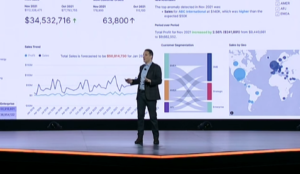With classic rock tunes playing, Adam Selipsky took the stage for his first re:Invent keynote as the new CEO of AWS, the $60-billion cloud juggernaut that was founded just 15 years ago. This was the first re:Invent without Andy Jassy, the charismatic leader who creatively used rock lyrics to tell product stories at past shows. The rock was still there, and product announcements abounded, but it’s clear Selipsky is charting his own path forward as the head of AWS.
Selipsky was one of Jassy’s top lieutenants before he left five years ago to head up another Seattle, Washington-area mainstays in the big data world, Tableau Software, so he’s very familiar with the company he’s now charged with growing. From his perspective, the growth of cloud computing over the years has been astounding.
“It’s hard to believe when we first got started, the concept of cloud computing barely existed,” Selipsky said during a two-hour keynote address from the re:Invent conference this morning. “I can’t tell you how many times I was asked, ‘Well, what does this have to do with selling books?’ Seriously. The answer of course was nothing! But the technology we used to sell books is everything to do with building and powering AWS.”
AWS has become a true IT powerhouse over the years. It has 100 trillion objects stored in S3, and 60 million EC2 instances are spun up every week. The company offers 200 services, ranging from compute, storage, and databases to machine learning. It’s now as big (or even bigger) as the large, slow-moving “old guard vendors” that Selipsky panned.
“Back then, IT and infrastructure just weren’t working. It was expensive slow. It was inflexible. It suffocated innovation and of course was dominated by old guard vendors who loved the expense and the lock-in,” Selipsky said. “There were skeptics, particularly amongst competitors who were really slow to respond. They said at first, ‘Ah, cloud’s not real, never gonna take off.’ Then they said, ‘Well, it’s only for startups.’ Then when enterprises really started to use the cloud, they said, ‘Well it’s currently not for mission critical workloads.’”
We’re at the point now where those mission critical workloads are starting to move to the cloud. Selipsky noted that, depending on who’s counting, only 5% to 15% of global IT spending (measured in the multiple trillions of dollars per year) is spent currently in the cloud. That means the total addressable market (TAM) for AMZM is still a potentially lucrative mountain to climb.
“But despite what feels like massive adoption, we’re actually just getting started,” Selipsky said. “There are so many workloads that are going to move in the coming years. Such innovation is yet to come, and it’s such an opportunity for all of us together.”
If AWS’s announcements today are any indication, that path forward will feature a heavy focus on data and analytics, which Selipsky said are key to AWS’ strategy.
The biggest announcement arguably was Amazon Sagemaker Canvas, a new code-free version of the popular machine learning development that AWS launched back in 2017 to develop machine learning applications. Uses don’t need specialized data science skills to create accurate ML apps with SageMaker Canvas, and it works with data resident in cloud and on-prem environments, Selipsky said.
“Now business users and analysts can use Canvas to generate highly accurate predictions using an intuitive and easy to use interface, without writing code and no ML experience,” Selipsky said. “Canvas uses terminology and visualizations that are already familiar to analysts and complements the data analytics tools that they’re already using.”
AWS had gone serverless with Athena and Glue, which are its managed services for Presto and ETL pipelines, respectively. Today, the company announced new serverless and on-demand deliverables for four more services, including Amazon Redshift, EMR (Elastic MapReduce), Amazon MSK (fully managed Apache Kafka), and Amazon Kinesis.
“So with these options, you don’t have to configure, scale, or manage clusters or servers,” Selipsky said. “You don’t have to worry about provisioning capacity. Fire them up and the services automatically scale in seconds when busy and scale back down when not. You pay only for the services you use.”
On the data lake front, AWS delivered a pair of new capabilities for Lake Formation, its service for helping customers to build data lakes on S3. That includes of Transactions for Governed Tables in Lake Formation, which simplifies the process of maintaining governance on tables shared in the S3 data lake.
“Now you can create a new type of table, a governed table, that supports ACID transactions,” Selipsky said. “So if this data is added or changed in S3, Lake Formation automatically manages conflicts and errors to give all users a consistent view of the data. This eliminates the need for custom error handling code or batching updates.”
The second Lake Formation enhancement brings row- and cell-level security for tables in the lake. This feature will simplify governed access to the data. “To give customized access to slices of data, traditionally you had to create and manage multiple copies of the data, keep all the copies in sync, and manage complex data pipelines. It’s a lot of heavy lifting,” Selipsky said. “So you asked us for a more targeted and direct way to govern access to your data lake, and to eliminate this heavy lifting and provide you that precision over access.”
The company also announced a new service for IBM mainframe customers to move to AWS. Called AWS Mainframe Modernization, the offering can help reduce the time required to migrate mainframe applications by two-thirds, Selipsky said.
“If you want to re platform and move your app over to AWS with minimal code changes, you can use mainframe modernizations recompilers to convert your code and testing services to make sure you don’t lose any functionality in the translation,” he said. “Now if you want to refactor decompose the application, you can just run the components in EC2, in containers in Lambda . Then our mainframe modernization service can actually automatically convert the COOBL code over to Java for you.”
AWS made several other announcements. Stay tuned to Datanami as we cover them throughout the show.
Related Items:
All Eyes on New AWS Boss Selipsky as re:Invent Kicks Off
AWS Leans on Custom Silicon for Processing Advantage
AWS Bolsters SageMaker with Data Prep, a Feature Store, and Pipelines
The post AWS Rocks with New Analytics, AI Services at re:Invent appeared first on Datanami.



0 Commentaires